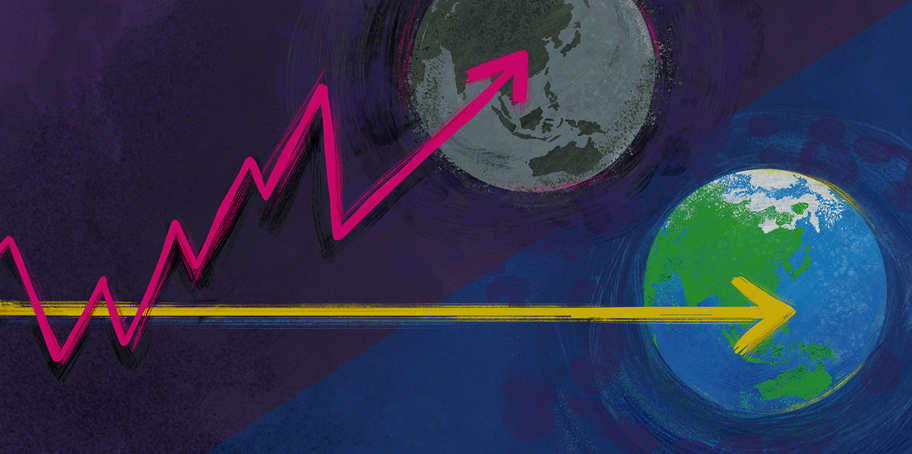January 8, 2019 — Both the U.S. economy and the global economy have expanded dramatically in the past century, as have life expectancies and material progress. Economists raised in this period of plenty assume that growth is good, necessary even, and should continue forever and ever without end, amen. Growth delivers jobs, returns on investment and higher tax revenues. What’s not to like? We’ve gotten so accustomed to growth that governments, corporations and banks now depend on it. It’s no exaggeration to say that we’re collectively addicted to growth.
The trouble is, a bigger economy uses more stuff than a smaller one, and we happen to live on a finite planet. So, an end to growth is inevitable. Ending growth is also desirable if we want to leave some stuff (minerals, forests, biodiversity and stable climate) for our kids and their kids. Further, if growth is meant to have anything to do with increasing quality of life, there is plenty of evidence to suggest it has passed the point of diminishing returns: Even though the U.S. economy is 5.5 times bigger now than it was in 1960 (in terms of real GDP), America is losing ground on its happiness index.
So how do we stop growth without making life miserable — and maybe even making it better?
To start with, there are two strategies that many people already agree on. We should substitute good consumption for bad, for example using renewable energy instead of fossil fuels. And we should use stuff more efficiently — making products that last longer and then repairing and recycling them instead of tossing them in a landfill. The reason these strategies are uncontroversial is that they reduce growth’s environmental damage without impinging on growth itself.
But renewable energy technology still requires materials (aluminum, glass, silicon and copper for solar panels; concrete, steel, copper and neodymium for wind turbines). And efficiency has limits. For example, we can reduce the time required to send a message to nearly zero, but from then on improvements are infinitesimal. In other words, substitution and efficiency are good, but they’re not sufficient. Even if we somehow arrive at a near-virtual economy, if it is growing we’ll still use more stuff, and the result will be pollution and resource depletion. Sooner or later, we have to do away with growth directly.
Getting Off Growth
If we’ve built our institutions to depend on growth, doesn’t that imply social pain and chaos if we go cold turkey? Perhaps. Getting off growth without a lot of needless disruption will require coordinated systemic changes, and those in turn will need nearly everyone’s buy-in. Policymakers will have to be transparent with regard to their actions, and citizens will want reliable information and incentives. Success will depend on minimizing pain and maximizing benefit.
The main key will be to focus on increasing equality. During the century of expansion, growth produced winners and losers, but many people tolerated economic inequality because they believed (usually mistakenly) that they’d one day get their share of the growth economy. During economic contraction, the best way to make the situation tolerable to a majority of people will be to increase equality. From a social standpoint, equality will serve as a substitute for growth. Policies to achieve equity are already widely discussed, and include full, guaranteed employment; a guaranteed minimum income; progressive taxation; and a maximum income.
These are ways to make economic shrinkage palatable; but how would policymakers actually go about putting the brakes on growth?
Meanwhile we could begin to boost quality of life simply by tracking it more explicitly: instead of focusing government policy on boosting GDP (the total dollar value of all goods and services produced domestically), why not aim to increase Gross National Happiness — as measured by a selected group of social indicators?
These are ways to make economic shrinkage palatable; but how would policymakers actually go about putting the brakes on growth?
One tactic would be to implement a shorter workweek. If people are working less, the economy will slow down — and meanwhile, everyone will have more time for family, rest and cultural activities.
We could also de-financialize the economy, discouraging wasteful speculation with a financial transaction tax and a 100 percent reserve requirement for banks.
Stabilizing population levels (by incentivizing small families and offering free reproductive health care) would make it easier to achieve equity and would also cap the numbers of both producers and consumers.
Caps should also be placed on resource extraction and pollution. Start with fossil fuels: annually declining caps on coal, oil and gas extraction would reduce energy use while protecting the climate.
Cooperative Conservatism
Altogether, reining in growth would come with a raft of environmental benefits. Carbon emissions would decline; resources ranging from forests to fish to topsoil would be preserved for future generations; and space would be left for other creatures, protecting the diversity of life on our precious planet. And these environmental benefits would quickly accrue to people, making life more beautiful, easy and happy for everyone.
Engineering a happy conclusion to the growth binge of the past century might be challenging. But it’s not impossible.
Granted, we’re talking about an unprecedented, coordinated economic shift that would require political will and courage. The result might be hard to pigeonhole in the capitalist-socialist terms of reference with which most of us are familiar. Perhaps we could think of it as cooperative conservatism (since its goal would be to conserve nature while maximizing mutual aid). It would require a lot of creative thinking on everyone’s part.
Sound difficult? Here’s the thing: ultimately, it’s not optional. The end of growth will come one day, perhaps very soon, whether we’re ready or not. If we plan for and manage it, we could well wind up with greater well-being. If we don’t, we could find ourselves like Wile E. Coyote plunging off a cliff. Engineering a happy conclusion to the growth binge of the past century might be challenging. But it’s not impossible; whereas what we’re currently trying to do — maintain perpetual growth of the economy on a finite planet — most assuredly is. ![]()
Editor’s note: The views expressed here are those of the author and not necessarily of Ensia. We present them to further discussion around important topics. We encourage you to respond with a comment below, following our commenting guidelines, which can be found on this page. In addition, you might consider submitting a Voices piece of your own. See Ensia’s Contact page for submission guidelines.
Related Posts
Ensia shares solutions-focused stories free of charge through our online magazine and partner media. That means audiences around the world have ready access to stories that can — and do — help them shape a better future. If you value our work, please show your support today.
Yes, I'll support Ensia!





We need to redesign the whole financing model (banks, stock exchanges in particular) and simply abolish the mindless profit at any cost mentality currently dominating the system.
Nothing will change until we dump the nineteenth century economic mentality and force business to follow different goals.
Political will is funded directly by big business and we need to align our objectives to survive here. Not on Mars...
And yes by now American and other fat economies are almost certainly already too big for long-term maintenance, which means we do need a period of degrowth to get back down to a sustainable steady state. But as we like to say at CASSE (www.steadystate.org), it’s one paradigm shift at a time. It will be the accomplishment of the 21st century to replace the nearly universal aspirations of GDP growth with “steady statesmanship” in national politics and international diplomacy. In the advanced stages of steady statesmanship, coordinated degrowth (always to be recognized as temporary) will be feasible.
Readers who want to help in this transition can start by signing the CASSE position on economic growth. (Richard and many other leading sustainability thinkers are among the 14,000 signatories.) And for details read Supply Shock: Economic Growth at the Crossroads and the Steady State Solution. That’s where you’ll find the basics of the Full and Sustainable Employment Act, or the “Full Seas Act” establishing the steady state economy as macroeconomic policy from the supply side and calling for steady statesmanship emanating from the USA.
https://postpeakmedicine.com/
1) Allow people other than CEOs and wall street bankers to have serious seats at economic policy tables. Policies should focus on enviornmental sustainabilty rather than growth.
2) The human race needs to accept the "hits and consequences" of this type of policy change short term and accept that this course change will lead to a better long term. Some of them could include:
* Some industries will fail or downsize
* Life will get simplier and not more complex
* We will have to do without certain gadgets
* Some services in our marketplace will vanish
* The stock market may take a downward spiral
* Not all debts will be repaid and some may be jubileed, and as the result some banks and credit card companies will fail.
* The retirement system will need to be rebuilt to survive a degrowth era and some may lose savings or fund growth
* It will mean accepting more integration between rich and poor living in the same neighborhood when re-localization occurs as focus will shift towards reducing commuting times and driving distances.
* Some things could become scarce
* Some towns could have buildings demolished and the farms put back in to reduce food transport
* More of the population may have to participate in agriculture
3) Optimize policies to reduce fossil fuel use in terms of relocalization, shorter distances to work, walkable cities, etc
4) Focus on quality of life as a higher national priority for the average person and the lower class than profit and loss statements for the upper class in terms of development priorities.
5) Focus on reducing consumption instead of increasing it.
6) Tax resources, fossil fuels, and minerals that are in short supply or will run out soon heavily to encourage conservation.
7) Use renewable energy and learn to live with its limitations.
8) Discourage and block big corporate mergers, leveraged buyouts, and sellouts and give priority to local and small companies. Muncipalities and the SEC should discourage plans to force locals out of business or buy them out.
9) Assemble goods close to where they are sold instead of shipping them to the place with the lowest labor cost. This would discourage unnecessary transport fuel use and preserve local jobs.
10) Use trains instead of big trucks when possible for transport of heavy or large quanties of items as they are more fuel efficent.
11) Use videoconferences over travel when possible
12) Optimize buildings for energy efficency as much as possible.
13) Change policies so that people do not lose everything when a debt isn't paid. In some cases, it may be better in a low growth economy to not take away items, homes, etc when one encounters unemployment, but instead jubilee or cut the debt or for the bank to eat the loss without punishment.
First step will be no taxes for all businesses. Give the society time to adjust. Then second step will be no need to pay salary for employees. Government will take care of them. Government will pay for food and shelter wherever they live and whatever they do. Finally, let people work in whatever area they want, but they must produce for the society.
Under MLE people will eventually focus on themselves, work for themselves, instead of somebody else. They will begin to think about the purpose of life, ask who am I, etc. Your idea - “And these environmental benefits would quickly accrue to people, making life more beautiful, easy and happy for everyone.” – will begin to take shape. Take a look at https://www.academia.edu/43619619/Truth_and_MLE_-the_only_way_for_Eternal_Global_Peace_on_Earth